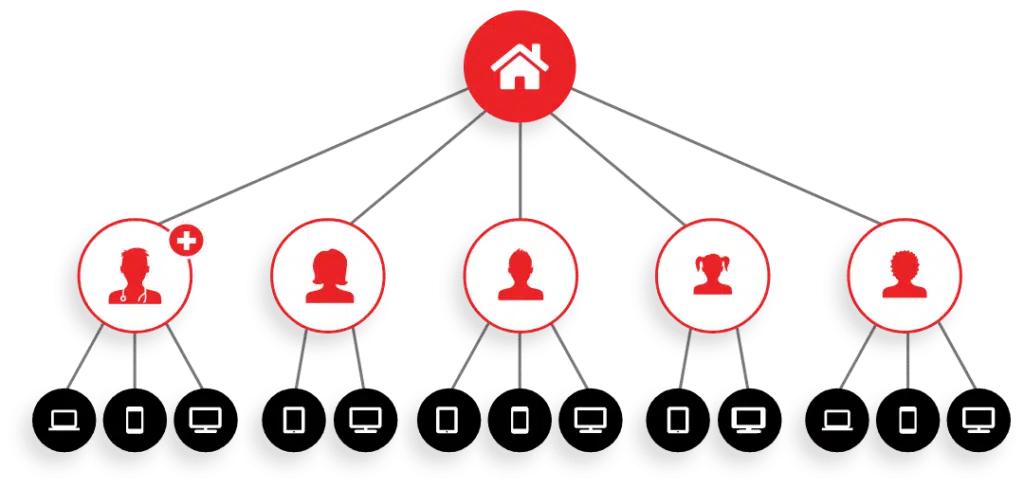Connected TV (CTV) continues to take the world by storm. Between 2015 and 2020, the number of CTV users in the US increased by ~30%.1 This meteoric rise has attracted advertisers, including those in healthcare, looking for exciting new inventory. CTV advertising will continue its ascent to stardom, with 73% of CTV buyers saying they’ll shift spending from broadcast and cable TV.2 This is big news, especially for healthcare brands that have always used linear TV. However, like all new advertising worlds, challenges of CTV advertising persist. Here’s how to overcome them.
CTV Advertising Challenge #1: Audience Identification
Challenge: It’s hard to identify HCPs at the user level.
While identifying HCPs is easier elsewhere online, the fragmentation of CTV makes it tough for you to identify them while they’re streaming. This is problematic because 57% of CTV households have three or more devices.3 Additionally, members of a household use the same login. Why’s this a problem? How effective will an ad promoting a new medical device be if the HCP’s 10-year-old son is the one seeing it? This opens the door to ad frequency issues. Since you don’t know if the HCP saw the ad, you won’t know how many times to serve it. According to data, 41% of marketers say identifying audiences across screens was a challenge of CTV advertising.4
Solution: Work with a partner with access to identity resolution technology.

The best way to identify HCPs on CTV is to work with a partner that has experience working with resolution ID technology, like Tapad’s CTV ID and Verizon’s Identity Graph. This technology takes CTV IDs and matches them with other digital device IDs to give you a more complete view of HCPs. For example, after they see your CTV ad, you can serve them another one while they’re on an app and another when they’re browsing the internet. This is only possible because you can identify them across these devices.
CTV Advertising Challenge #2: Measurement and Reporting
Challenge: The CTV industry doesn’t have a standard set of metrics and guidelines.
39%
The percentange of digital marketers who said that the lack of uniforms cross-channel measurement standards is a challenge.
Thirty-nine percent of marketers said the lack of uniform cross-channel measurement standards is a challenge.5 Further challenges exist when you consider that the CTV industry hasn’t adopted a standard set of metrics and guidelines. Said another way, there’s no definitive definition of performance metrics such as reach and frequency. As a result, you can’t have total confidence your ad dollars aren’t going to waste.
Solution: Invest in cross-device technology and mature CTV ecosystems.
A unified standard of measurement is coming. Until then, your best bet is to invest in existing cross-device technology as well as more mature CTV options. Roku, for example, partnered with Nielsen, paving the way for an independent and standardized metric.
CTV Advertising Challenge #3: Smart Scaling
Challenge: CTV doesn’t have the scale of other channels.
CTV’s reach still pales in comparison to other options. The collective reach of social media is nearly 4 billion people—that’s a 200,000% difference (based on a CTV audience size of 200,000 million).6 Your scale is hampered further with some CTV players, like Netflix, not offering an ad-supported model. Ecosystems touting billions of active users—and millions of HCPs—are irresistible, which is why ad spending on social and Youtube, for example, is through the roof. If you’re looking for scale and reach, CTV advertising won’t cut it—at least right now.
Solution: Use cross-channel HCP advertising.

Due to the issues with scale, you shouldn’t rely on CTV advertising as a standalone tactic. Instead, layer CTV onto what you already have and use cross-device and resolution technology to run larger campaigns that achieve the scale you want.
CTV Advertising: An Upside You Can’t Ignore
CTV advertising offers a lot of benefits you can’t ignore. For example, targeting capabilities, albeit in silos, are impressive. So too are the ad types available—and the ones on the way. For example, the fact that 71% of CTV viewers use mobile devices while watching TV is making way for second-screen experiences.7 Additionally, the adoption of header bidding will accelerate CTV advertising’s growth. So, while challenges exist, primarily revolving around audience identification, measurement and reporting, and scale, you’d be wise to navigate them and bask in the glory that CTV has to offer your HCP campaigns.
Sources
- Vailshery LS. Number of connected TV users in the United States from 2015 to 2022. Statista. Published August 2018. Accessed May 14, 2021.
- Tremor Video. New Research Finds That 72% of US Digital Advertisers Believe CTV Reaches Audiences More Effectively Than Linear TV. Global Newswire. Published April 14, 2021. Accessed May 14, 2021.
- Amazon. The State of Connected TV Report 2020. Amazon. Published 2020. Accessed May 14, 2021.
- Statista Research Department. Challenges of connected TV advertising in the U.S. 2021
- Published by Statista Research Department, Apr 8, 2021. Statista. Published April 8, 2021. Accessed May 14, 2021.
- Dean D. Social Network Usage & Growth Statistics: How Many People Use Social Media in 2021?. Backlinko. Published April 26, 2021. Accessed May 14, 2021.
- Verizon Media. Verizon Media amplifies CTV engagement with Interactive Ads. Verizon Media. Published September 16, 2020. Accessed May 14, 2021.
